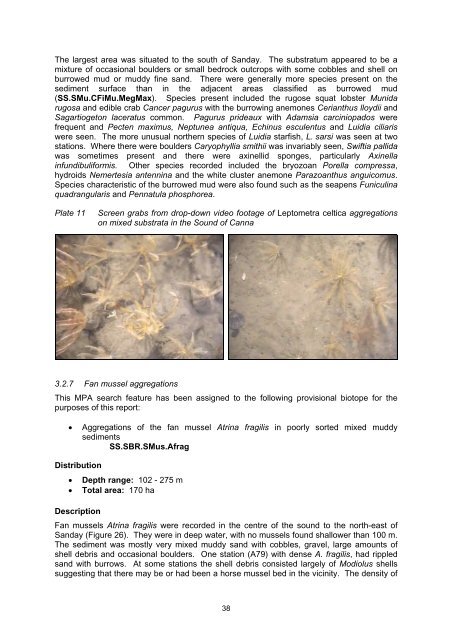Marine biological survey to establish the distribution and status of ...
Marine biological survey to establish the distribution and status of ...
Marine biological survey to establish the distribution and status of ...
You also want an ePaper? Increase the reach of your titles
YUMPU automatically turns print PDFs into web optimized ePapers that Google loves.
The largest area was situated <strong>to</strong> <strong>the</strong> south <strong>of</strong> S<strong>and</strong>ay. The substratum appeared <strong>to</strong> be a<br />
mixture <strong>of</strong> occasional boulders or small bedrock outcrops with some cobbles <strong>and</strong> shell on<br />
burrowed mud or muddy fine s<strong>and</strong>. There were generally more species present on <strong>the</strong><br />
sediment surface than in <strong>the</strong> adjacent areas classified as burrowed mud<br />
(SS.SMu.CFiMu.MegMax). Species present included <strong>the</strong> rugose squat lobster Munida<br />
rugosa <strong>and</strong> edible crab Cancer pagurus with <strong>the</strong> burrowing anemones Cerianthus lloydii <strong>and</strong><br />
Sagartioge<strong>to</strong>n laceratus common. Pagurus prideaux with Adamsia carciniopados were<br />
frequent <strong>and</strong> Pecten maximus, Neptunea antiqua, Echinus esculentus <strong>and</strong> Luidia ciliaris<br />
were seen. The more unusual nor<strong>the</strong>rn species <strong>of</strong> Luidia starfish, L. sarsi was seen at two<br />
stations. Where <strong>the</strong>re were boulders Caryophyllia smithii was invariably seen, Swiftia pallida<br />
was sometimes present <strong>and</strong> <strong>the</strong>re were axinellid sponges, particularly Axinella<br />
infundibuliformis. O<strong>the</strong>r species recorded included <strong>the</strong> bryozoan Porella compressa,<br />
hydroids Nemertesia antennina <strong>and</strong> <strong>the</strong> white cluster anemone Parazoanthus anguicomus.<br />
Species characteristic <strong>of</strong> <strong>the</strong> burrowed mud were also found such as <strong>the</strong> seapens Funiculina<br />
quadrangularis <strong>and</strong> Pennatula phosphorea.<br />
Plate 11<br />
Screen grabs from drop-down video footage <strong>of</strong> Lep<strong>to</strong>metra celtica aggregations<br />
on mixed substrata in <strong>the</strong> Sound <strong>of</strong> Canna<br />
3.2.7 Fan mussel aggregations<br />
This MPA search feature has been assigned <strong>to</strong> <strong>the</strong> following provisional bio<strong>to</strong>pe for <strong>the</strong><br />
purposes <strong>of</strong> this report:<br />
Aggregations <strong>of</strong> <strong>the</strong> fan mussel Atrina fragilis in poorly sorted mixed muddy<br />
sediments<br />
SS.SBR.SMus.Afrag<br />
Distribution<br />
<br />
<br />
Description<br />
Depth range: 102 - 275 m<br />
Total area: 170 ha<br />
Fan mussels Atrina fragilis were recorded in <strong>the</strong> centre <strong>of</strong> <strong>the</strong> sound <strong>to</strong> <strong>the</strong> north-east <strong>of</strong><br />
S<strong>and</strong>ay (Figure 26). They were in deep water, with no mussels found shallower than 100 m.<br />
The sediment was mostly very mixed muddy s<strong>and</strong> with cobbles, gravel, large amounts <strong>of</strong><br />
shell debris <strong>and</strong> occasional boulders. One station (A79) with dense A. fragilis, had rippled<br />
s<strong>and</strong> with burrows. At some stations <strong>the</strong> shell debris consisted largely <strong>of</strong> Modiolus shells<br />
suggesting that <strong>the</strong>re may be or had been a horse mussel bed in <strong>the</strong> vicinity. The density <strong>of</strong><br />
38

















